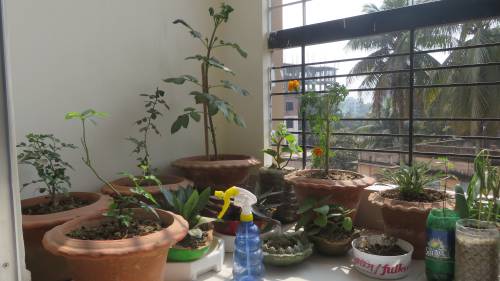
FAQ About Indoor Vertical Gardening

What is indoor vertical gardening?
Indoor vertical gardening involves growing plants in a vertically stacked manner within an indoor space. This method often uses containers, shelves, or wall-mounted systems to maximize space and create a lush green environment in homes, offices, or other indoor locations. Vertical gardens are ideal for small spaces and can transform bare walls into living pieces of art.

What are the benefits of indoor vertical gardening?
Indoor vertical gardening offers numerous benefits, including maximizing limited space, improving air quality, enhancing aesthetic appeal, and reducing stress. It allows individuals to grow a variety of plants in confined areas, making it suitable for urban living. Additionally, plants can help purify the air by removing toxins and producing oxygen, contributing to a healthier indoor environment.

Which plants are suitable for indoor vertical gardening?
Many plants thrive in indoor vertical gardens, including herbs like basil and mint, leafy greens such as lettuce and spinach, and decorative plants like pothos and philodendrons. When selecting plants, consider the light conditions of your space, as some plants require more sunlight than others. Always choose plants that suit your indoor environment to ensure healthy growth.

How can limited indoor space be maximized using vertical gardening?
Vertical gardening maximizes limited indoor space by utilizing vertical surfaces like walls and shelves instead of floor space. By stacking plants vertically, you can create multiple layers of greenery that turn bare walls into productive eco-friendly spaces. This method is especially beneficial in small apartments or offices where floor space is limited.

What design ideas are popular for indoor vertical gardens?
Popular design ideas for indoor vertical gardens include using pockets, shelves, hanging planters, and modular planting systems. These setups can be customized to fit any space and can incorporate different types of plants for aesthetic diversity. Adding a mix of trailing vines, flowering plants, and various textures can create a visually appealing garden design indoors.

Do indoor vertical gardens require special lighting?
Yes, many indoor vertical gardens may require special grow lights, especially if natural sunlight is limited. LED grow lights are popular choices, as they are energy-efficient and can be adjusted to accommodate the light needs of different plant species. Ensuring adequate lighting is crucial for the healthy growth of plants in indoor vertical gardens.

How do you water plants in an indoor vertical garden?
Watering an indoor vertical garden depends on the system used. Some vertical gardens come equipped with built-in irrigation systems that automatically water the plants. For DIY systems, watering can be done manually using a watering can or hose attachment, ensuring even and gentle water dispersion across all plants. It's important to avoid overwatering, which can cause root rot.

Can vegetables be grown in indoor vertical gardens?
Yes, vegetables like lettuce, spinach, cherry tomatoes, and peppers can be successfully grown in indoor vertical gardens. These plants often require consistent lighting and watering schedules, so setting up an efficient lighting system and ensuring regular care will enhance growth. Growing vegetables indoors can complement a home cooking routine with fresh, home-grown ingredients.

What are some challenges of indoor vertical gardening?
Some challenges include managing light exposure, ensuring proper watering techniques, and maintaining humidity levels suitable for plant growth. Additionally, space constraints can limit the types of plants that can be grown. Monitoring plant health regularly and making adjustments as needed can help mitigate these challenges effectively.

How can one start an indoor vertical garden on a budget?
To start an indoor vertical garden on a budget, consider using recycled materials such as plastic bottles, old pallets, or shoe organizers as plant holders. Additionally, propagate plants from cuttings, buy seeds instead of grown plants, and use natural lighting to reduce costs. DIY solutions can be both economical and creatively satisfying.

Is it possible to grow fruit in an indoor vertical garden?
While challenging, it is possible to grow small fruits like strawberries and dwarf citrus varieties in an indoor vertical garden. These plants may require extra care in terms of lighting and fertilization. Selecting dwarf or compact varieties that adapt well to container living is essential for successful fruit production indoors.

How do you maintain an indoor vertical garden?
Maintaining an indoor vertical garden involves regular watering, monitoring light conditions, pruning to promote healthy growth, and checking for pests. It's also important to regularly clean any support structures or containers to prevent mold or bacterial growth. Regular maintenance will ensure the health and longevity of the garden.

What is the best way to control pests in an indoor vertical garden?
Pest control in indoor vertical gardens can be managed using natural methods like neem oil or insecticidal soap. It's crucial to regularly inspect plants and remove any affected leaves or pests by hand. Maintaining proper humidity and air circulation can prevent pest infestations. Beneficial insects such as ladybugs or predatory mites can also be introduced as a natural control method.

Can vertical gardens help with indoor air quality?
Yes, vertical gardens can significantly improve indoor air quality. Plants absorb carbon dioxide and release oxygen, and specific varieties can filter harmful toxins from the air. As such, vertical gardens not only beautify a space but also enhance the overall health and comfort of the indoor environment.

Do indoor vertical gardens affect humidity levels?
Indoor vertical gardens can slightly increase humidity levels, as plants release moisture into the air through the process of transpiration. This can be beneficial in dry indoor environments. Monitoring and maintaining balanced humidity levels through occasional ventilation can optimize conditions for both the plants and the indoor space.

Are there specific systems or kits for creating indoor vertical gardens?
Yes, several commercial systems and kits are available for building indoor vertical gardens. These include options like wall planters, hydroponic systems, and modular plant towers, which come with the necessary materials for set-up. These kits vary in complexity and price, allowing gardeners to choose products that fit their skill level and budget.

How do you choose the right vertical gardening system for your needs?
Choosing the right indoor vertical gardening system depends on factors such as available space, budget, and personal aesthetic preferences. Consider the types of plants you want to grow and their light and water requirements. Systems range from simple planters or pockets to more complex hydroponic setups, so select an option that meets your specific gardening goals and living environment.

Can indoor vertical gardens reduce home energy costs?
Indoor vertical gardens have the potential to reduce energy costs by naturally insulating the space. Plants can help stabilize temperature fluctuations and increase humidity, reducing the need for artificial heating or cooling. Although the energy savings might be modest, every little bit helps in promoting a sustainable living environment.

What materials are commonly used for DIY indoor vertical gardens?
Common materials for DIY indoor vertical gardens include wooden pallets, plastic bottles, metal grids, and PVC pipes. Recycled or upcycled materials are popular choices due to their cost-effectiveness and environmental friendliness. Creativity in combining these materials can lead to innovative and custom-designed vertical gardens tailored to specific spaces.
